
Aeromachus dubius, the dingy scrub-hopper, is a butterfly belonging to the family Hesperiidae. It ranges from India to China, including Malaya, Assam, Myanmar, Laos, Vietnam, Hainan and Yunnan.

Halpe homolea, the Indian ace or Ceylon ace, is a butterfly belonging to the family Hesperiidae.

Halpe porus, or Moore's ace, is a butterfly belonging to the family Hesperiidae, found in India.
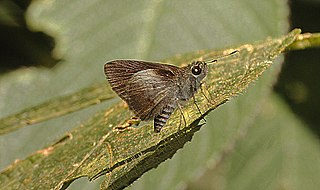
Suastus minuta, the small palm bob, is a butterfly belonging to the family Hesperiidae. It is found in the Indomalayan realm - south India, Sikkim to Burma, Sri Lanka, Thailand, Laos, Hainan, Vietnam and Malaya.
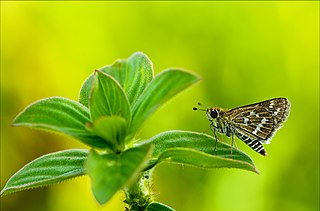
Taractrocera maevius, the common grass dart, is a butterfly belonging to the family Hesperiidae found in India, Sri Lanka and Myanmar.
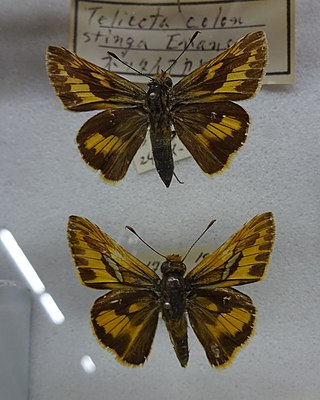
Telicota colon, commonly known as the pale palm dart or common palm dart, is a butterfly belonging to the family Hesperiidae found in India to Australia.

Thoressa astigmata, the southern spotted ace, is a butterfly belonging to the family Hesperiidae. The species was first described by Charles Swinhoe in 1890. It is endemic to the Western Ghats of India and is found in the states of Kerala, Tamil Nadu and Karnataka.
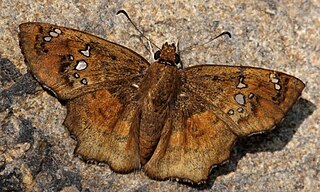
Abaratha agama, the spotted angle, is a species of butterfly belonging to the family Hesperiidae. It is found from southern India to Myanmar and in Thailand, Laos, Vietnam, southern China, Java and Sulawesi. The species was first described by Frederic Moore in 1857.

Abaratha alida, the yellow spotted angle or Alida angle, is a butterfly belonging to the family Hesperiidae. It is found in India, Sri Lanka, Myanmar, Thailand, Vietnam, Laos, Hainan and southern China. It was first described by Lionel de Nicéville in 1891.

Gomalia is a monotypic genus of hesperiid butterfly. Gomalia elma, the marbled skipper or African marbled skipper, is found in Africa and parts of Asia.

Odontoptilum angulata, the chestnut angle or banded angle, is a butterfly belonging to the family Hesperiidae and is found in India and southeast Asia.
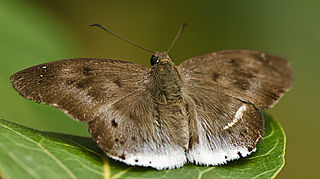
Tagiades japetus, commonly known as the pied flat or the common snow flat, is a species of spread-winged skipper butterfly belonging to the family Hesperiidae. It is widely distributed, being found from India, the Himalayas, Southeast Asia, to Australia. It contains several recognized subspecies.

Tagiades litigiosa, the water snow flat, is a butterfly belonging to the family Hesperiidae which is found in India, Sri Lanka, and Myanmar.

Ionolyce helicon, the pointed lineblue, or bronze lineblue, is a small butterfly found in the Indomalayan realm that belongs to the lycaenids or blues family.
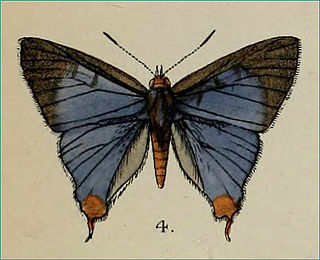
Cigaritis abnormis, the abnormal silverline, is a species of lycaenid or blue butterfly found in south India and Pakistan.

Zesius chrysomallus, the redspot, is a species of lycaenid or blue butterfly found in Sri Lanka and India.

Tajuria jehana, the plains blue royal, is a species of lycaenid or blue butterfly found in Asia.

Tajuria cippus, the peacock royal, is a species of lycaenid or blue butterfly found in the Indomalayan realm.

Horaga onyx, the common onyx, is a species of lycaenid or blue butterfly found in Asia.

Zeltus is a butterfly genus in the family Lycaenidae, the blues. It is monotypic containing the species Zeltus amasa, the fluffy tit, a small butterfly found in Indomalayan realm. The butterfly is found in India, specially the Western Ghats, Sikkim to Assam. It can also be found in Myanmar, Thailand, West Malaysia, Sumatra, Borneo, Java and the Philippines.

























